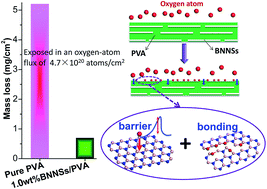Size-selected boron nitride nanosheets as oxygen-atom corrosion resistant fillers†
Abstract
Size-selected boron nitride nanosheets (BNNSs) were explored to enhance the polymer's oxygen-atom corrosion resistance. BNNSs with three kinds of average lateral size were prepared by a size selection route. All these BNNSs could enhance the polymer's oxygen-atom corrosion resistance, but we found much greater enhancement by using larger BNNSs, i.e. adding ∼1.0 wt% large BNNSs (∼21.4 μm2) can achieve 87% decrease in the polymer's mass loss. BNNSs' barrier and bonding effects are responsible for the enhanced resistance. These results throw light on resisting oxygen-atom corrosion by BNNSs with controllable size.


 Please wait while we load your content...
Please wait while we load your content...